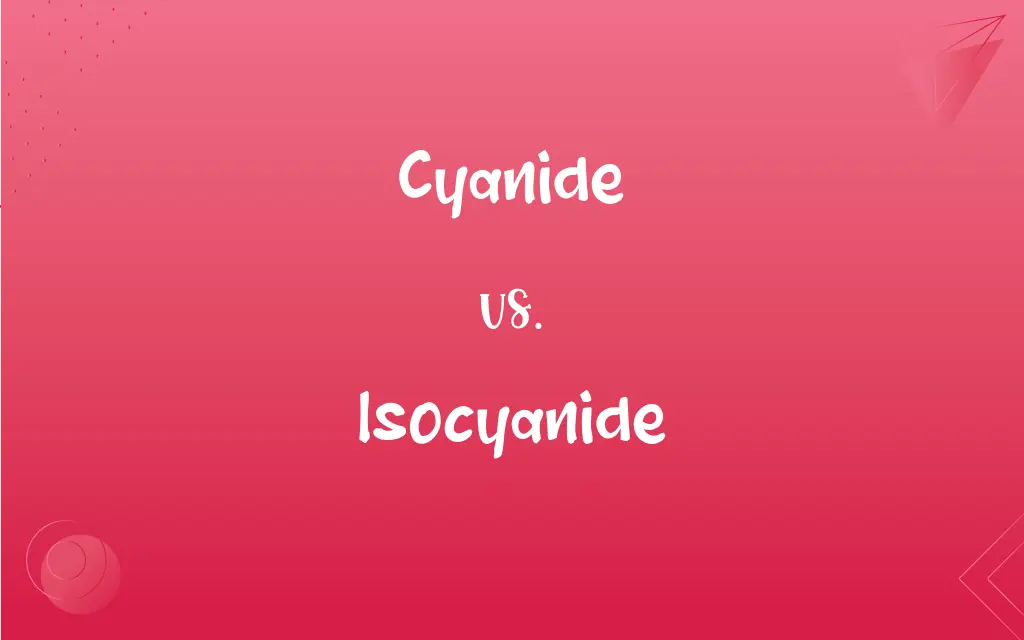Cyanide vs. Isocyanide: What's the Difference?
Edited by Aimie Carlson || By Janet White || Published on January 21, 2024
Cyanides are compounds with a carbon-nitrogen bond and a negative charge, while isocyanides have a reversed bonding order with a nitrogen-carbon bond.

Key Differences
Cyanides contain a carbon atom triple-bonded to a nitrogen atom (C≡N), whereas isocyanides have a nitrogen atom triple-bonded to a carbon atom (N≡C).
Cyanides are known for their high toxicity and are used in various industrial applications. Isocyanides, while also toxic, are more reactive and are utilized in specialized chemical syntheses.
Cyanides are more stable and well-studied, with numerous applications in chemical processes. Isocyanides are less stable, with a distinct, often unpleasant odor.
Cyanides can be found in certain plants and are used in mining. Isocyanides are primarily laboratory-synthesized and are important in pharmaceutical research.
The bonding order in cyanides and isocyanides makes them structural isomers. This difference in bonding significantly alters their chemical behavior and applications.
ADVERTISEMENT
Comparison Chart
Chemical Structure
Carbon triple-bonded to nitrogen (C≡N)
Nitrogen triple-bonded to carbon (N≡C)
Toxicity
Highly toxic
Also toxic, but more reactive
Stability
Generally more stable
Less stable, with a strong odor
Common Uses
Mining, industrial processes
Specialized chemical syntheses
Chemical Properties
Found in nature, well-studied
Mostly laboratory-synthesized
ADVERTISEMENT
Cyanide and Isocyanide Definitions
Cyanide
Found in certain plants and seeds.
Apple seeds contain small amounts of cyanide.
Isocyanide
Less stable than cyanides, with a strong odor.
Isocyanides are known for their distinctly unpleasant smell.
Cyanide
A chemical compound containing a cyano group.
Cyanide poisoning can be fatal if not treated immediately.
Isocyanide
Reactive compounds used in specialized syntheses.
Isocyanides play a crucial role in multicomponent reactions.
Cyanide
Used in the synthesis of various chemicals.
Cyanide is a key reagent in organic chemistry.
Isocyanide
Structural isomers of cyanides.
Despite being isomers, isocyanides and cyanides have different properties.
Cyanide
Toxic compound used in industrial applications.
Cyanide is used in gold mining to extract gold from ore.
Isocyanide
A chemical compound with a nitrogen-carbon bond.
Isocyanides are used in the synthesis of pharmaceuticals.
Cyanide
A compound with a carbon-nitrogen bond.
Cyanide ions can bond with metals to form salts.
Isocyanide
Laboratory-synthesized chemical reagents.
Isocyanides are prepared in the lab for research purposes.
Cyanide
The anionic univalent CN group, or any of various salts or esters of hydrogen cyanide containing a CN group, especially the extremely poisonous compounds potassium cyanide and sodium cyanide.
Isocyanide
(chemistry) The isomer HN+C- of hydrocyanic acid HCN.
Cyanide
To treat (a metal surface) with cyanide to produce a hard surface.
Isocyanide
(chemistry) Any of its hydrocarbyl derivatives RNC.
Cyanide
To treat (an ore) with cyanide to extract gold or silver.
Cyanide
Any compound containing the -C≡N group or the CN− anion.
Cyanide
(uncountable) Sodium or potassium cyanide, used in the extraction of gold and silver or as a poison.
Cyanide
(uncountable) Hydrogen cyanide, or cyanide gas, a poisonous gas.
Cyanide
(transitive) To treat or poison with cyanide.
Cyanide
A compound formed by the union of cyanogen with an element or radical.
Cyanide
Any of a class of organic compounds containing the cyano radical -CN
Cyanide
An extremely poisonous salt of hydrocyanic acid
FAQs
How are isocyanides synthesized?
They are mostly synthesized in laboratories.
What is isocyanide?
A chemical compound with a nitrogen-carbon bond.
What are the uses of cyanide?
In mining, chemical synthesis, and industrial processes.
Are cyanides naturally occurring?
Yes, in certain plants and seeds.
What makes isocyanides unique in chemistry?
Their high reactivity and use in specialized syntheses.
Can cyanide be found in food?
In trace amounts in certain seeds and fruits.
How are cyanides detected?
Through chemical tests and analysis.
What is cyanide?
A toxic chemical compound containing a carbon-nitrogen bond.
Are isocyanides used in medicine?
They are important in pharmaceutical research.
Do isocyanides have a distinct smell?
Yes, they are known for their strong, unpleasant odor.
What are cyanide salts?
Compounds formed when cyanide ions bond with metals.
What is the main difference in the structure of cyanides and isocyanides?
The bonding order of carbon and nitrogen.
What precautions are needed when handling cyanides?
Proper safety gear and protocols due to their toxicity.
Do isocyanides have industrial applications?
Primarily used in specialized chemical research.
Is cyanide dangerous?
Extremely toxic and can be fatal if ingested.
Are isocyanides soluble in water?
Their solubility varies depending on the specific compound.
Can cyanides be used in pest control?
Historically, but their use is heavily regulated due to toxicity.
How are cyanide poisonings treated?
With immediate medical attention and specific antidotes.
What role do isocyanides play in organic chemistry?
They are valuable reagents in building complex molecules.
Can isocyanides form stable compounds?
They are generally less stable than cyanides.
About Author
Written by
Janet WhiteJanet White has been an esteemed writer and blogger for Difference Wiki. Holding a Master's degree in Science and Medical Journalism from the prestigious Boston University, she has consistently demonstrated her expertise and passion for her field. When she's not immersed in her work, Janet relishes her time exercising, delving into a good book, and cherishing moments with friends and family.
Edited by
Aimie CarlsonAimie Carlson, holding a master's degree in English literature, is a fervent English language enthusiast. She lends her writing talents to Difference Wiki, a prominent website that specializes in comparisons, offering readers insightful analyses that both captivate and inform.







































































